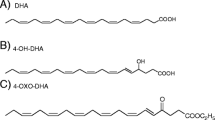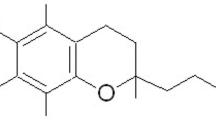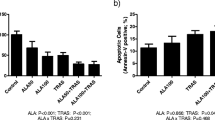Abstract
In vitro work suggests that conjugated linoleic acid (CLA) isomers (c9,t11 and t10,c12) are cytotoxic to human breast cancer cells, however the mechanism remains unknown. Using human MCF-7 breast cancer cells, we examined the effects of c9,t11 and t10,c12 CLA compared to oleic acid (OA), linoleic acid (LA), or untreated cells on cell membrane phospholipid composition, cell survival, and the insulin-like growth factor-I (IGF-I) and the downstream insulin receptor substrate-1 (IRS-1). Both CLA isomers were incorporated into membrane phospholipids (p < 0.05). Compared to untreated cells, c9,t11 or t10,c12 CLA significantly reduced the metabolic activity of IGF-I stimulated MCF-7 cells, increased lactate dehydrogenase (LDH) release, and decreased cellular concentrations of the IGF-I receptor (IGF-IR) and insulin receptor substrate-1 (p < 0.05). Incubation with t10,c12 CLA also reduced the levels of phosphorylated IGF-1R. The effects on all of these measures were greater (p < 0.05) for t10,c12 CLA compared to c9,t11 CLA. There were few differences between LA-treated and c9,t11 CLA-treated cells, whereas cellular metabolic activity, LDH release, and IGF-IR concentrations differed between t10,c12 CLA-treated and LA-treated cells (p < 0.05). OA stimulated growth compared to the untreated condition (p < 0.05). In summary, this study demonstrated that the t10,c12 CLA isomer inhibits growth of MCF-7 cells and suggested that this may be mediated through incorporation into cellular phospholipids and interference with the function of IGF-I and related signaling proteins.





Similar content being viewed by others
Abbreviations
- AA:
-
Arachidonic acid
- BSA:
-
Bovine serum albumin
- c9, t11 CLA:
-
Cis-9, trans-11 CLA
- CLA:
-
Conjugated linoleic acid
- DHA:
-
Docosahexaenoic acid
- DMEM:
-
Dulbecco’s modified Eagle medium
- FBS:
-
Fetal bovine serum
- IGF-I:
-
Insulin-like growth factor I
- IGF-IR:
-
Insulin-like growth factor-I receptor
- IRS-1:
-
Insulin receptor substrate-1
- LA:
-
Linoleic acid
- LDH:
-
Lactate dehydrogenase
- MUFA:
-
Monounsaturated fatty acids
- OA:
-
Oleic Acid
- PUFA:
-
Polyunsaturated fatty acid
- SFA:
-
Saturated fatty acids
- t10,c12 CLA:
-
trans-10, cis-12 CLA
References
Sebedio JL, Gnaedig S, Chardigny JM (1999) Recent advances in conjugated linoleic acid research. Curr Opin Clin Nutr Metab Care 2:499–506
Dhiman TR, Nam SH, Ure AL (2005) Factors affecting conjugated linoleic acid content in milk and meat. Crit Rev Food Sci Nutr 45:463–482
Kelley NS, Hubbard NE, Erickson KL (2007) Conjugated linoleic acid isomers and cancer. J Nutr 137:2599–2607
Ip C, Dong Y, Ip MM, Banni S, Carta G, Angioni E, Murru E, Spada S, Melis MP, Saebo A (2002) Conjugated linoleic acid isomers and mammary cancer prevention. Nutr Cancer 43:52–58
Ip MM, Masso-Welch PA, Ip C (2003) Prevention of mammary cancer with conjugated linoleic acid: role of the stroma and the epithelium. J Mammary Gland Biol Neoplasia 8:103–118
Wang LS, Huang YW, Sugimoto Y, Liu S, Chang HL, Ye W, Shu S, Lin YC (2005) Effects of human breast stromal cells on conjugated linoleic acid (CLA) modulated vascular endothelial growth factor-A (VEGF-A) expression in MCF-7 cells. Anticancer Res 25:4061–4068
Park Y, Allen KG, Shultz TD (2000) Modulation of MCF-7 breast cancer cell signal transduction by linoleic acid and conjugated linoleic acid in culture. Anticancer Res 20:669–676
Ma DW, Field CJ, Clandinin MT (2002) An enriched mixture of trans-10, cis-12-CLA inhibits linoleic acid metabolism and PGE2 synthesis in MDA-MB-231 cells. Nutr Cancer 44:203–212
Kemp MQ, Jeffy BD, Romagnolo DF (2003) Conjugated linoleic acid inhibits cell proliferation through a p53-dependent mechanism: effects on the expression of G1-restriction points in breast and colon cancer cells. J Nutr 133:3670–3677
Chujo H, Yamasaki M, Nou S, Koyanagi N, Tachibana H, Yamada K (2003) Effect of conjugated linoleic acid isomers on growth factor-induced proliferation of human breast cancer cells. Cancer Lett 202:81–87
Grunicke HH (1991) The cell membrane as a target for cancer chemotherapy. Eur J Cancer 27:281–284
Schley PD, Brindley DN, Field CJ (2007) (n-3) PUFA alter raft lipid composition and decrease epidermal growth factor receptor levels in lipid rafts of human breast cancer cells. J Nutr 137:548–553
Pollak MN (2004) Insulin-like growth factors and neoplasia. Novartis Found Symp 262:84–98
Schernhammer ES, Holly JM, Pollak MN, Hankinson SE (2005) Circulating levels of insulin-like growth factors, their binding proteins, and breast cancer risk. Cancer Epidemiol Biomarkers Prev 14:699–704
Renehan AG, Zwahlen M, Minder C, O’dwyer ST, Shalet SM, Egger M (2004) Insulin-like growth factor (IGF)-I, IGF binding protein-3, and cancer risk: systematic review and meta-regression analysis. Lancet 363:1346–1353
Kleinberg DL, Feldman M, Ruan W (2000) IGF-I: an essential factor in terminal end bud formation and ductal morphogenesis. J Mammary Gland Biol Neoplasia 5:7–17
Sternlicht MD (2006) Key stages in mammary gland development: the cues that regulate ductal branching morphogenesis. Breast Cancer Res 8:201
Ip C, Singh M, Thompson HJ, Scimeca JA (1994) Conjugated linoleic acid suppresses mammary carcinogenesis and proliferative activity of the mammary gland in the rat. Cancer Res 54:1212–1215
Kim EJ, Kang IJ, Cho HJ, Kim WK, Ha YL, Park JH (2003) Conjugated linoleic acid downregulates insulin-like growth factor-I receptor levels in HT-29 human colon cancer cells. J Nutr 133:2675–2681
Kaburagi Y, Yamauchi T, Yamamoto-Honda R, Ueki K, Tobe K, Akanuma Y, Yazaki Y, Kadowaki T (1999) The mechanism of insulin-induced signal transduction mediated by the insulin receptor substrate family. Endocr J 46(Suppl):S25–S34
Zhang J, Du YY, Lin YF, Chen YT, Yang L, Wang HJ, Ma D (2008) The cell growth suppressor, mir-126, targets IRS-1. Biochem Biophys Res Commun 377:136–140
Peyrat JP, Bonneterre J, Dusanter-Fourt I, Leroy-Martin B, Djiane J, Demaille A (1989) Characterization of insulin-like growth factor 1 receptors (IGF1-R) in human breast cancer cell lines. Bull Cancer 76:311–319
Keating AF, Kennelly JJ, Zhao FQ (2006) Characterization and regulation of the bovine stearoyl-CoA desaturase gene promoter. Biochem Biophys Res Commun 344:233–240
Folch J, Lees M, Sloane Stanley GH (1957) A simple method for the isolation and purification of total lipides from animal tissues. J Biol Chem 226:497–509
Field CJ, Ryan EA, Thomson AB, Clandinin MT (1988) Dietary fat and the diabetic state alter insulin binding and the fatty acyl composition of the adipocyte plasma membrane. Biochem J 253:417–424
Kramer JK, Fellner V, Dugan ME, Sauer FD, Mossoba MM, Yurawecz MP (1997) Evaluating acid and base catalysts in the methylation of milk and rumen fatty acids with special emphasis on conjugated dienes and total trans fatty acids. Lipids 32:1219–1228
Cruz-Hernandez C, Kramer JK, Kennelly JJ, Glimm DR, Sorensen BM, Okine EK, Goonewardene LA, Weselake RJ (2007) Evaluating the conjugated linoleic acid and trans 18:1 isomers in milk fat of dairy cows fed increasing amounts of sunflower oil and a constant level of fish oil. J Dairy Sci 90:3786–3801
Schley PD, Jijon HB, Robinson LE, Field CJ (2005) Mechanisms of omega-3 fatty acid-induced growth inhibition in MDA-MB-231 human breast cancer cells. Breast Cancer Res Treat 92:187–195
Ip C, Chin SF, Scimeca JA, Pariza MW (1991) Mammary cancer prevention by conjugated dienoic derivative of linoleic acid. Cancer Res 51:6118–6124
Tanmahasamut P, Liu J, Hendry LB, Sidell N (2004) Conjugated linoleic acid blocks estrogen signaling in human breast cancer cells. J Nutr 134:674–680
Cho HJ, Kim WK, Jung JI, Kim EJ, Lim SS, Kwon DY, Park JH (2005) Trans-10, cis-12, not cis-9, trans-11, conjugated linoleic acid decreases ErbB3 expression in HT-29 human colon cancer cells. World J Gastroenterol 11:5142–5150
Banni S, Angioni E, Casu V, Melis MP, Carta G, Corongiu FP, Thompson H, Ip C (1999) Decrease in linoleic acid metabolites as a potential mechanism in cancer risk reduction by conjugated linoleic acid. Carcinogenesis 20:1019–1024
Turpeinen AM, Barlund S, Freese R, Lawrence P, Brenna JT (2006) Effects of conjugated linoleic acid on linoleic and linolenic acid metabolism in man. Br J Nutr 95:727–733
Majumder B, Wahle KW, Moir S, Schofield A, Choe SN, Farquharson A, Grant I, Heys SD (2002) Conjugated linoleic acids (CLAs) regulate the expression of key apoptotic genes in human breast cancer cells. FASEB J 16:1447–1449
Seo JH, Moon HS, Kim IY, Guo DD, Lee HG, Choi YJ, Cho CS (2008) PEGylated conjugated linoleic acid stimulation of apoptosis via a p53-mediated signaling pathway in MCF-7 breast cancer cells. Eur J Pharm Biopharm 70:621–626
Guo DD, Moon HS, Arote R, Seo JH, Quan JS, Choi YJ, Cho CS (2007) Enhanced anticancer effect of conjugated linoleic acid by conjugation with pluronic F127 on MCF-7 breast cancer cells. Cancer Lett 254(2):244–254
Miglietta A, Bozzo F, Gabriel L, Bocca C, Canuto RA (2006) Extracellular signal-regulated kinase 1/2 and protein phosphatase 2A are involved in the antiproliferative activity of conjugated linoleic acid in MCF-7 cells. Br J Nutr 96:22–27
Stubbs CD, Smith AD (1984) The modification of mammalian membrane polyunsaturated fatty acid composition in relation to membrane fluidity and function. Biochim Biophys Acta 779:89–137
Grimble RF, Tappia PS (1995) Modulatory influence of unsaturated fatty acids on the biology of tumour necrosis factor-alpha. Biochem Soc Trans 23:282–287
Yin JJ, Mossoba MM, Kramer JK, Yurawecz MP, Eulitz K, Morehouse KM, Ku Y (1999) Effects of conjugated linoleic acid on oxygen diffusion-concentration product and depletion in membranes by using electron spin resonance spin-label oximetry. Lipids 34:1017–1023
Uehara H, Suganuma T, Negishi S, Uda Y, Furukawa Y, Ueno S, Sato KJ (2008) Physical properties of two isomers of conjugated linoleic acid. Am Oil Chem Soc 85:29–36
Hardy S, Langelier Y, Prentki M (2000) Oleate activates phosphatidylinositol 3-kinase and promotes proliferation and reduces apoptosis of MDA-MB-231 breast cancer cells, whereas palmitate has opposite effects. Cancer Res 60:6353–6358
Przybytkowski E, Joly E, Nolan CJ, Hardy S, Francoeur AM, Langelier Y, Prentki M (2007) Upregulation of cellular triacylglycerol—free fatty acid cycling by oleate is associated with long-term serum-free survival of human breast cancer cells. Biochem Cell Biol 85:301–310
Hardy S, El-Assaad W, Przybytkowski E, Joly E, Prentki M, Langelier Y (2003) Saturated fatty acid-induced apoptosis in MDA-MB-231 breast cancer cells. A role for cardiolipin. J Biol Chem 278:31861–31870
Hulbert AJ, Turner N, Storlien LH, Else PL (2005) Dietary fats and membrane function: implications for metabolism and disease. Biol Rev Camb Philos Soc 80:155–169
Spector AA, Burns CP (1987) Biological and therapeutic potential of membrane lipid modification in tumors. Cancer Res 47:4529–4537
Yorek M, Leeney E, Dunlap J, Ginsberg B (1989) Effect of fatty acid composition on insulin and IGF-I binding in retinoblastoma cells. Invest Ophthalmol Vis Sci 30:2087–2092
Brown DA, London E (1998) Functions of lipid rafts in biological membranes. Annu Rev Cell Dev Biol 14:111–136
Huo H, Guo X, Hong S, Jiang M, Liu X, Liao K (2003) Lipid rafts/caveolae are essential for insulin-like growth factor–1 receptor signaling during 3T3-L1 preadipocyte differentiation induction. J Biol Chem 278:11561–11569
Remacle-Bonnet M, Garrouste F, Baillat G, Andre F, Marvaldi J, Pommier G (2005) Membrane rafts segregate pro- from anti-apoptotic insulin-like growth factor-I receptor signaling in colon carcinoma cells stimulated by members of the tumor necrosis factor superfamily. Am J Pathol 167:761–773
desBordes C, Lea MA (1995) Effects of C18 fatty acid isomers on DNA synthesis in hepatoma and breast cancer cells. Anticancer Res 15:2017–2021
Choi Y, Park Y, Storkson JM, Pariza MW, Ntambi JM (2002) Inhibition of stearoyl-CoA desaturase activity by the cis-9, trans-11 isomer and the trans-10, cis-12 isomer of conjugated linoleic acid in MDA-MB-231 and MCF–7 human breast cancer cells. Biochem Biophys Res Commun 294:785–790
Visonneau S, Cesano A, Tepper SA, Scimeca JA, Santoli D, Kritchevsky D (1997) Conjugated linoleic acid suppresses the growth of human breast adenocarcinoma cells in SCID mice. Anticancer Res 17:969–973
Hubbard NE, Lim D, Erickson KL (2003) Effect of separate conjugated linoleic acid isomers on murine mammary tumorigenesis. Cancer Lett 190:13–19
Corl BA, Barbano DM, Bauman DE, Ip C (2003) cis-9, trans-11 CLA derived endogenously from trans-11 18:1 reduces cancer risk in rats. J Nutr 133:2893–2900
Lock AL, Corl BA, Barbano DM, Bauman DE, Ip C (2004) The anticarcinogenic effect of trans-11 18:1 is dependent on its conversion to cis-9, trans-11 CLA by delta9-desaturase in rats. J Nutr 134:2698–2704
Acknowledgments
The authors would like to acknowledge the help of Patricia Biondo in putting together this manuscript and the technical assistance of Marnie Newell, Paige Sorochan and Susan Goruk. D. Amarù was the recipient of a post-graduate studentship from the Natural Sciences and Engineering Research Council of Canada. Funding for this study came from the CLA network through a grant from the Alberta Agriculture Research Funding Consortium.
Author information
Authors and Affiliations
Corresponding author
About this article
Cite this article
Amarù, D.L., Field, C.J. Conjugated Linoleic Acid Decreases MCF-7 Human Breast Cancer Cell Growth and Insulin-Like Growth Factor-1 Receptor Levels. Lipids 44, 449–458 (2009). https://doi.org/10.1007/s11745-009-3288-4
Received:
Accepted:
Published:
Issue Date:
DOI: https://doi.org/10.1007/s11745-009-3288-4




